Economic Evaluation of the Anxiety Free Program - HSH 719 Essay
VerifiedAdded on 2023/01/23
|8
|2654
|56
Essay
AI Summary
This essay evaluates the economic aspects of the "Anxiety Free" program designed to prevent anxiety in secondary school students. It explores various economic evaluation methods, including cost-effectiveness and cost-utility analysis, to assess the program's efficiency and impact. The essay discusses the allocation of limited resources, the estimation of resource requirements, and the benefits of economic evaluation in making informed decisions about intervention strategies. It differentiates between cost-utility and cost-effectiveness analyses, highlighting the importance of quality-adjusted life-years (QALYs) in measuring the program's effectiveness. Furthermore, the essay outlines the resources considered, including healthcare, other sectors, patients, and productivity losses, and details how to determine healthcare costs using bottom-up methods and the use of resource costing. The essay also explores the steps involved in determining healthcare costs and the valuation of health outcomes, emphasizing the importance of performance measurement and feedback from parents.
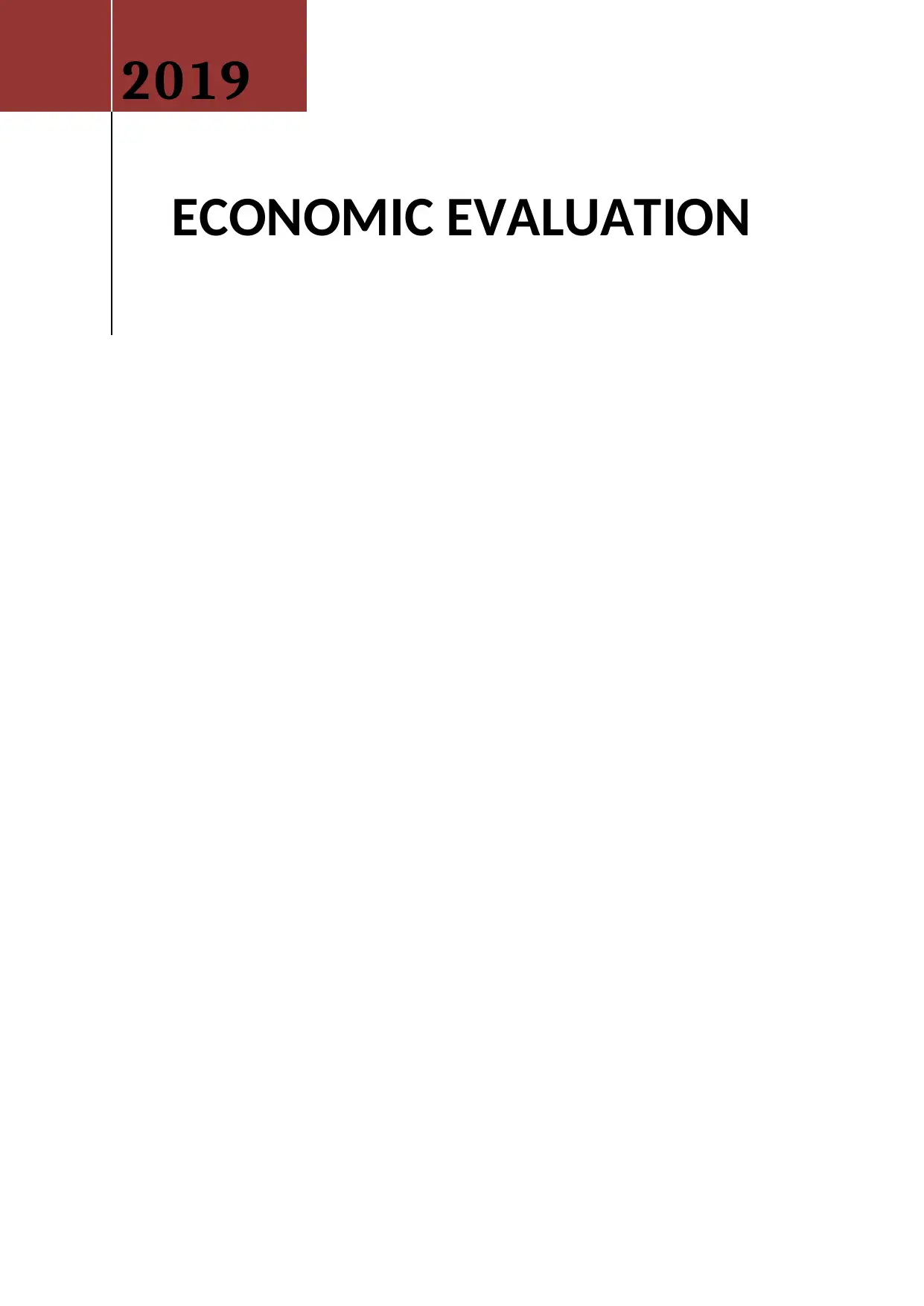
ECONOMIC EVALUATION
2019
2019
Paraphrase This Document
Need a fresh take? Get an instant paraphrase of this document with our AI Paraphraser
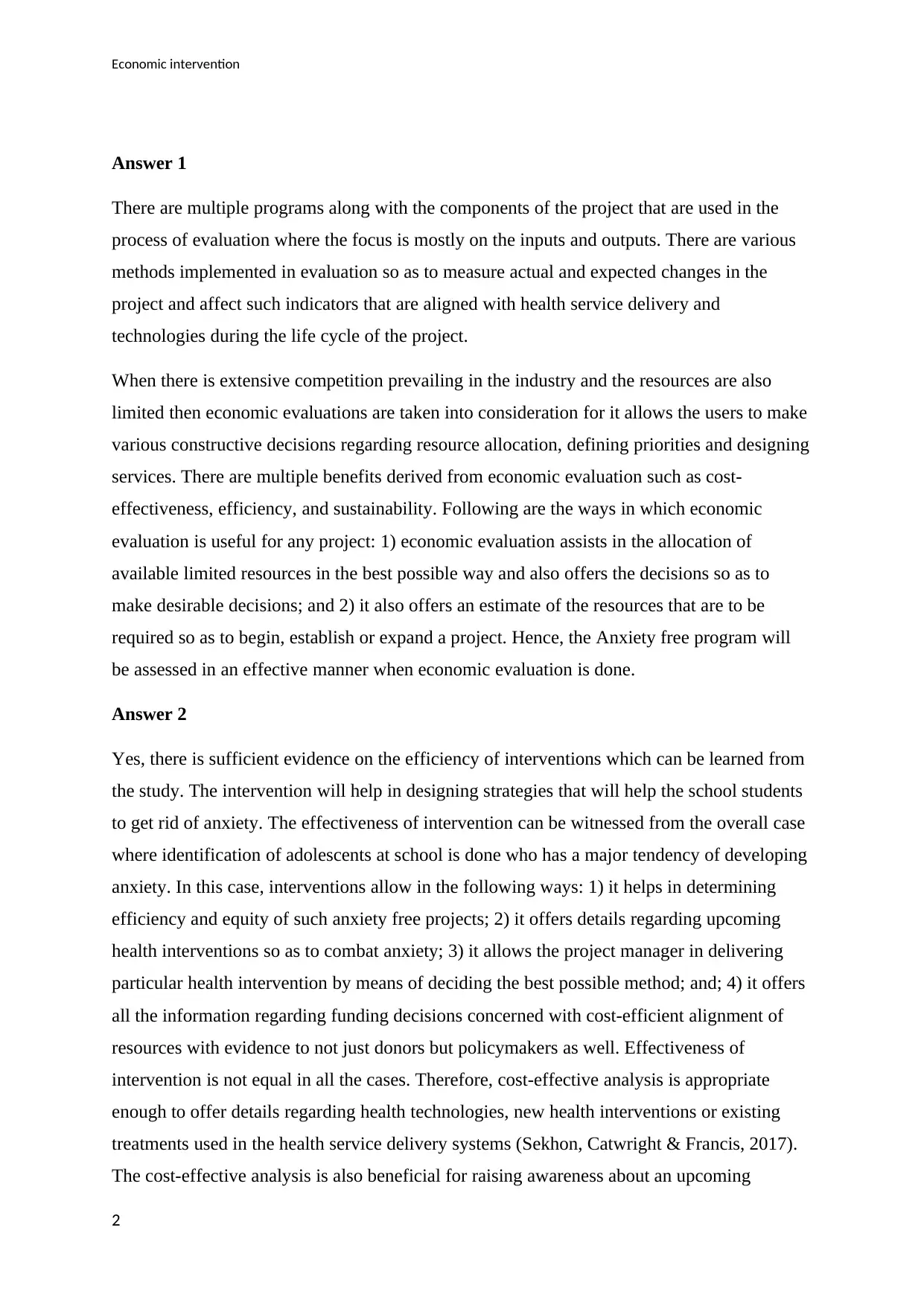
Economic intervention
Answer 1
There are multiple programs along with the components of the project that are used in the
process of evaluation where the focus is mostly on the inputs and outputs. There are various
methods implemented in evaluation so as to measure actual and expected changes in the
project and affect such indicators that are aligned with health service delivery and
technologies during the life cycle of the project.
When there is extensive competition prevailing in the industry and the resources are also
limited then economic evaluations are taken into consideration for it allows the users to make
various constructive decisions regarding resource allocation, defining priorities and designing
services. There are multiple benefits derived from economic evaluation such as cost-
effectiveness, efficiency, and sustainability. Following are the ways in which economic
evaluation is useful for any project: 1) economic evaluation assists in the allocation of
available limited resources in the best possible way and also offers the decisions so as to
make desirable decisions; and 2) it also offers an estimate of the resources that are to be
required so as to begin, establish or expand a project. Hence, the Anxiety free program will
be assessed in an effective manner when economic evaluation is done.
Answer 2
Yes, there is sufficient evidence on the efficiency of interventions which can be learned from
the study. The intervention will help in designing strategies that will help the school students
to get rid of anxiety. The effectiveness of intervention can be witnessed from the overall case
where identification of adolescents at school is done who has a major tendency of developing
anxiety. In this case, interventions allow in the following ways: 1) it helps in determining
efficiency and equity of such anxiety free projects; 2) it offers details regarding upcoming
health interventions so as to combat anxiety; 3) it allows the project manager in delivering
particular health intervention by means of deciding the best possible method; and; 4) it offers
all the information regarding funding decisions concerned with cost-efficient alignment of
resources with evidence to not just donors but policymakers as well. Effectiveness of
intervention is not equal in all the cases. Therefore, cost-effective analysis is appropriate
enough to offer details regarding health technologies, new health interventions or existing
treatments used in the health service delivery systems (Sekhon, Catwright & Francis, 2017).
The cost-effective analysis is also beneficial for raising awareness about an upcoming
2
Answer 1
There are multiple programs along with the components of the project that are used in the
process of evaluation where the focus is mostly on the inputs and outputs. There are various
methods implemented in evaluation so as to measure actual and expected changes in the
project and affect such indicators that are aligned with health service delivery and
technologies during the life cycle of the project.
When there is extensive competition prevailing in the industry and the resources are also
limited then economic evaluations are taken into consideration for it allows the users to make
various constructive decisions regarding resource allocation, defining priorities and designing
services. There are multiple benefits derived from economic evaluation such as cost-
effectiveness, efficiency, and sustainability. Following are the ways in which economic
evaluation is useful for any project: 1) economic evaluation assists in the allocation of
available limited resources in the best possible way and also offers the decisions so as to
make desirable decisions; and 2) it also offers an estimate of the resources that are to be
required so as to begin, establish or expand a project. Hence, the Anxiety free program will
be assessed in an effective manner when economic evaluation is done.
Answer 2
Yes, there is sufficient evidence on the efficiency of interventions which can be learned from
the study. The intervention will help in designing strategies that will help the school students
to get rid of anxiety. The effectiveness of intervention can be witnessed from the overall case
where identification of adolescents at school is done who has a major tendency of developing
anxiety. In this case, interventions allow in the following ways: 1) it helps in determining
efficiency and equity of such anxiety free projects; 2) it offers details regarding upcoming
health interventions so as to combat anxiety; 3) it allows the project manager in delivering
particular health intervention by means of deciding the best possible method; and; 4) it offers
all the information regarding funding decisions concerned with cost-efficient alignment of
resources with evidence to not just donors but policymakers as well. Effectiveness of
intervention is not equal in all the cases. Therefore, cost-effective analysis is appropriate
enough to offer details regarding health technologies, new health interventions or existing
treatments used in the health service delivery systems (Sekhon, Catwright & Francis, 2017).
The cost-effective analysis is also beneficial for raising awareness about an upcoming
2
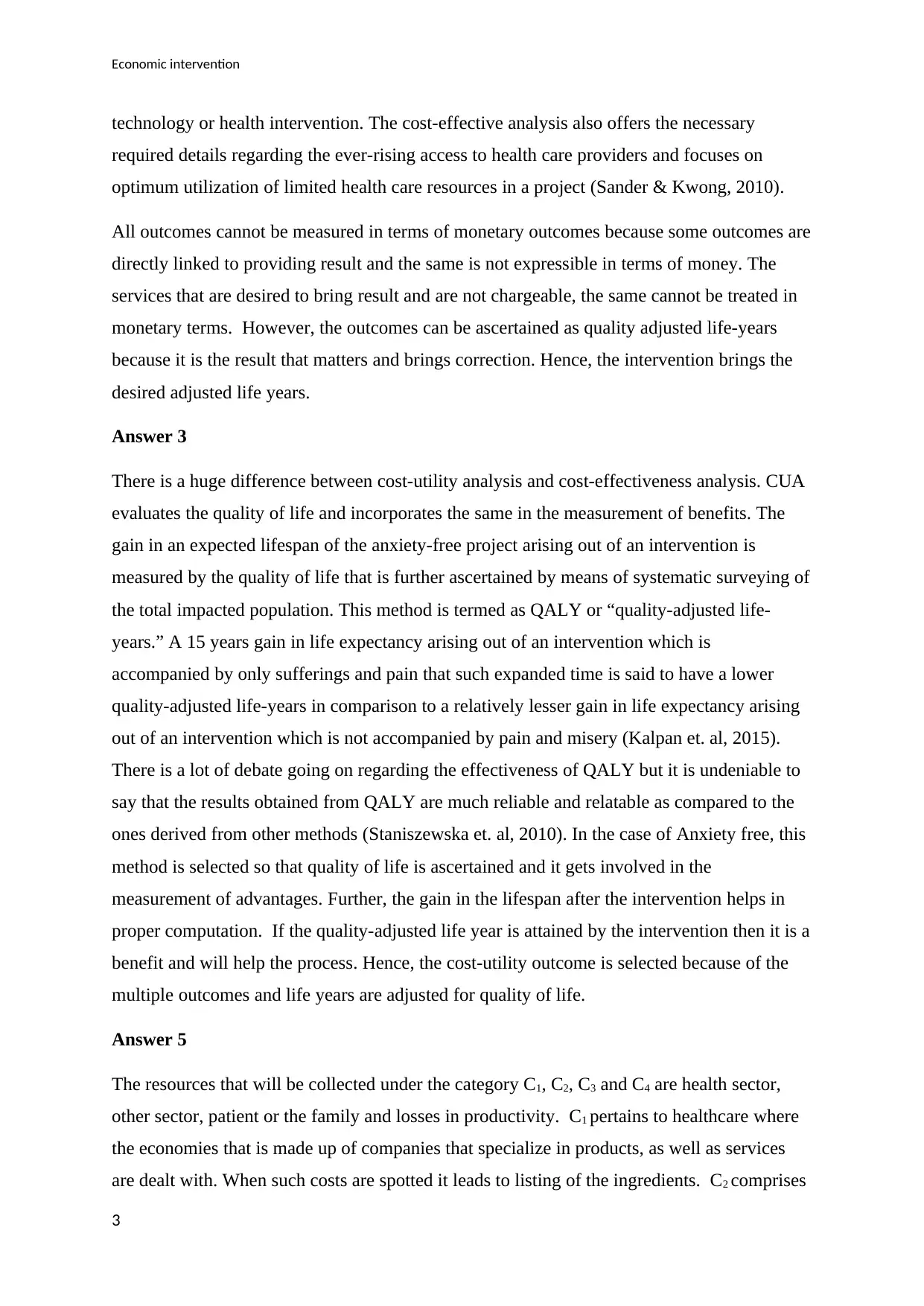
Economic intervention
technology or health intervention. The cost-effective analysis also offers the necessary
required details regarding the ever-rising access to health care providers and focuses on
optimum utilization of limited health care resources in a project (Sander & Kwong, 2010).
All outcomes cannot be measured in terms of monetary outcomes because some outcomes are
directly linked to providing result and the same is not expressible in terms of money. The
services that are desired to bring result and are not chargeable, the same cannot be treated in
monetary terms. However, the outcomes can be ascertained as quality adjusted life-years
because it is the result that matters and brings correction. Hence, the intervention brings the
desired adjusted life years.
Answer 3
There is a huge difference between cost-utility analysis and cost-effectiveness analysis. CUA
evaluates the quality of life and incorporates the same in the measurement of benefits. The
gain in an expected lifespan of the anxiety-free project arising out of an intervention is
measured by the quality of life that is further ascertained by means of systematic surveying of
the total impacted population. This method is termed as QALY or “quality-adjusted life-
years.” A 15 years gain in life expectancy arising out of an intervention which is
accompanied by only sufferings and pain that such expanded time is said to have a lower
quality-adjusted life-years in comparison to a relatively lesser gain in life expectancy arising
out of an intervention which is not accompanied by pain and misery (Kalpan et. al, 2015).
There is a lot of debate going on regarding the effectiveness of QALY but it is undeniable to
say that the results obtained from QALY are much reliable and relatable as compared to the
ones derived from other methods (Staniszewska et. al, 2010). In the case of Anxiety free, this
method is selected so that quality of life is ascertained and it gets involved in the
measurement of advantages. Further, the gain in the lifespan after the intervention helps in
proper computation. If the quality-adjusted life year is attained by the intervention then it is a
benefit and will help the process. Hence, the cost-utility outcome is selected because of the
multiple outcomes and life years are adjusted for quality of life.
Answer 5
The resources that will be collected under the category C1, C2, C3 and C4 are health sector,
other sector, patient or the family and losses in productivity. C1 pertains to healthcare where
the economies that is made up of companies that specialize in products, as well as services
are dealt with. When such costs are spotted it leads to listing of the ingredients. C2 comprises
3
technology or health intervention. The cost-effective analysis also offers the necessary
required details regarding the ever-rising access to health care providers and focuses on
optimum utilization of limited health care resources in a project (Sander & Kwong, 2010).
All outcomes cannot be measured in terms of monetary outcomes because some outcomes are
directly linked to providing result and the same is not expressible in terms of money. The
services that are desired to bring result and are not chargeable, the same cannot be treated in
monetary terms. However, the outcomes can be ascertained as quality adjusted life-years
because it is the result that matters and brings correction. Hence, the intervention brings the
desired adjusted life years.
Answer 3
There is a huge difference between cost-utility analysis and cost-effectiveness analysis. CUA
evaluates the quality of life and incorporates the same in the measurement of benefits. The
gain in an expected lifespan of the anxiety-free project arising out of an intervention is
measured by the quality of life that is further ascertained by means of systematic surveying of
the total impacted population. This method is termed as QALY or “quality-adjusted life-
years.” A 15 years gain in life expectancy arising out of an intervention which is
accompanied by only sufferings and pain that such expanded time is said to have a lower
quality-adjusted life-years in comparison to a relatively lesser gain in life expectancy arising
out of an intervention which is not accompanied by pain and misery (Kalpan et. al, 2015).
There is a lot of debate going on regarding the effectiveness of QALY but it is undeniable to
say that the results obtained from QALY are much reliable and relatable as compared to the
ones derived from other methods (Staniszewska et. al, 2010). In the case of Anxiety free, this
method is selected so that quality of life is ascertained and it gets involved in the
measurement of advantages. Further, the gain in the lifespan after the intervention helps in
proper computation. If the quality-adjusted life year is attained by the intervention then it is a
benefit and will help the process. Hence, the cost-utility outcome is selected because of the
multiple outcomes and life years are adjusted for quality of life.
Answer 5
The resources that will be collected under the category C1, C2, C3 and C4 are health sector,
other sector, patient or the family and losses in productivity. C1 pertains to healthcare where
the economies that is made up of companies that specialize in products, as well as services
are dealt with. When such costs are spotted it leads to listing of the ingredients. C2 comprises
3
⊘ This is a preview!⊘
Do you want full access?
Subscribe today to unlock all pages.

Trusted by 1+ million students worldwide
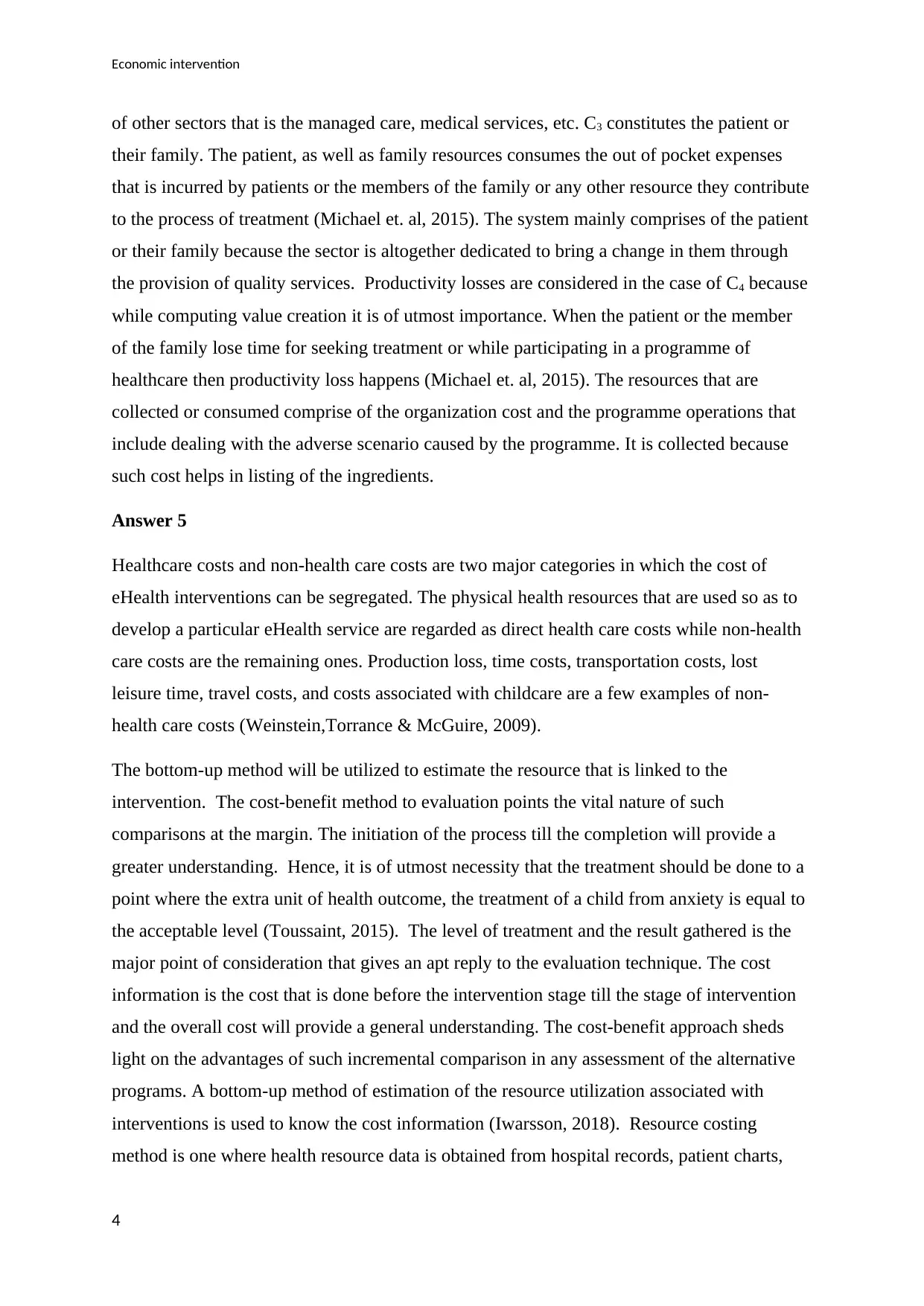
Economic intervention
of other sectors that is the managed care, medical services, etc. C3 constitutes the patient or
their family. The patient, as well as family resources consumes the out of pocket expenses
that is incurred by patients or the members of the family or any other resource they contribute
to the process of treatment (Michael et. al, 2015). The system mainly comprises of the patient
or their family because the sector is altogether dedicated to bring a change in them through
the provision of quality services. Productivity losses are considered in the case of C4 because
while computing value creation it is of utmost importance. When the patient or the member
of the family lose time for seeking treatment or while participating in a programme of
healthcare then productivity loss happens (Michael et. al, 2015). The resources that are
collected or consumed comprise of the organization cost and the programme operations that
include dealing with the adverse scenario caused by the programme. It is collected because
such cost helps in listing of the ingredients.
Answer 5
Healthcare costs and non-health care costs are two major categories in which the cost of
eHealth interventions can be segregated. The physical health resources that are used so as to
develop a particular eHealth service are regarded as direct health care costs while non-health
care costs are the remaining ones. Production loss, time costs, transportation costs, lost
leisure time, travel costs, and costs associated with childcare are a few examples of non-
health care costs (Weinstein,Torrance & McGuire, 2009).
The bottom-up method will be utilized to estimate the resource that is linked to the
intervention. The cost-benefit method to evaluation points the vital nature of such
comparisons at the margin. The initiation of the process till the completion will provide a
greater understanding. Hence, it is of utmost necessity that the treatment should be done to a
point where the extra unit of health outcome, the treatment of a child from anxiety is equal to
the acceptable level (Toussaint, 2015). The level of treatment and the result gathered is the
major point of consideration that gives an apt reply to the evaluation technique. The cost
information is the cost that is done before the intervention stage till the stage of intervention
and the overall cost will provide a general understanding. The cost-benefit approach sheds
light on the advantages of such incremental comparison in any assessment of the alternative
programs. A bottom-up method of estimation of the resource utilization associated with
interventions is used to know the cost information (Iwarsson, 2018). Resource costing
method is one where health resource data is obtained from hospital records, patient charts,
4
of other sectors that is the managed care, medical services, etc. C3 constitutes the patient or
their family. The patient, as well as family resources consumes the out of pocket expenses
that is incurred by patients or the members of the family or any other resource they contribute
to the process of treatment (Michael et. al, 2015). The system mainly comprises of the patient
or their family because the sector is altogether dedicated to bring a change in them through
the provision of quality services. Productivity losses are considered in the case of C4 because
while computing value creation it is of utmost importance. When the patient or the member
of the family lose time for seeking treatment or while participating in a programme of
healthcare then productivity loss happens (Michael et. al, 2015). The resources that are
collected or consumed comprise of the organization cost and the programme operations that
include dealing with the adverse scenario caused by the programme. It is collected because
such cost helps in listing of the ingredients.
Answer 5
Healthcare costs and non-health care costs are two major categories in which the cost of
eHealth interventions can be segregated. The physical health resources that are used so as to
develop a particular eHealth service are regarded as direct health care costs while non-health
care costs are the remaining ones. Production loss, time costs, transportation costs, lost
leisure time, travel costs, and costs associated with childcare are a few examples of non-
health care costs (Weinstein,Torrance & McGuire, 2009).
The bottom-up method will be utilized to estimate the resource that is linked to the
intervention. The cost-benefit method to evaluation points the vital nature of such
comparisons at the margin. The initiation of the process till the completion will provide a
greater understanding. Hence, it is of utmost necessity that the treatment should be done to a
point where the extra unit of health outcome, the treatment of a child from anxiety is equal to
the acceptable level (Toussaint, 2015). The level of treatment and the result gathered is the
major point of consideration that gives an apt reply to the evaluation technique. The cost
information is the cost that is done before the intervention stage till the stage of intervention
and the overall cost will provide a general understanding. The cost-benefit approach sheds
light on the advantages of such incremental comparison in any assessment of the alternative
programs. A bottom-up method of estimation of the resource utilization associated with
interventions is used to know the cost information (Iwarsson, 2018). Resource costing
method is one where health resource data is obtained from hospital records, patient charts,
4
Paraphrase This Document
Need a fresh take? Get an instant paraphrase of this document with our AI Paraphraser
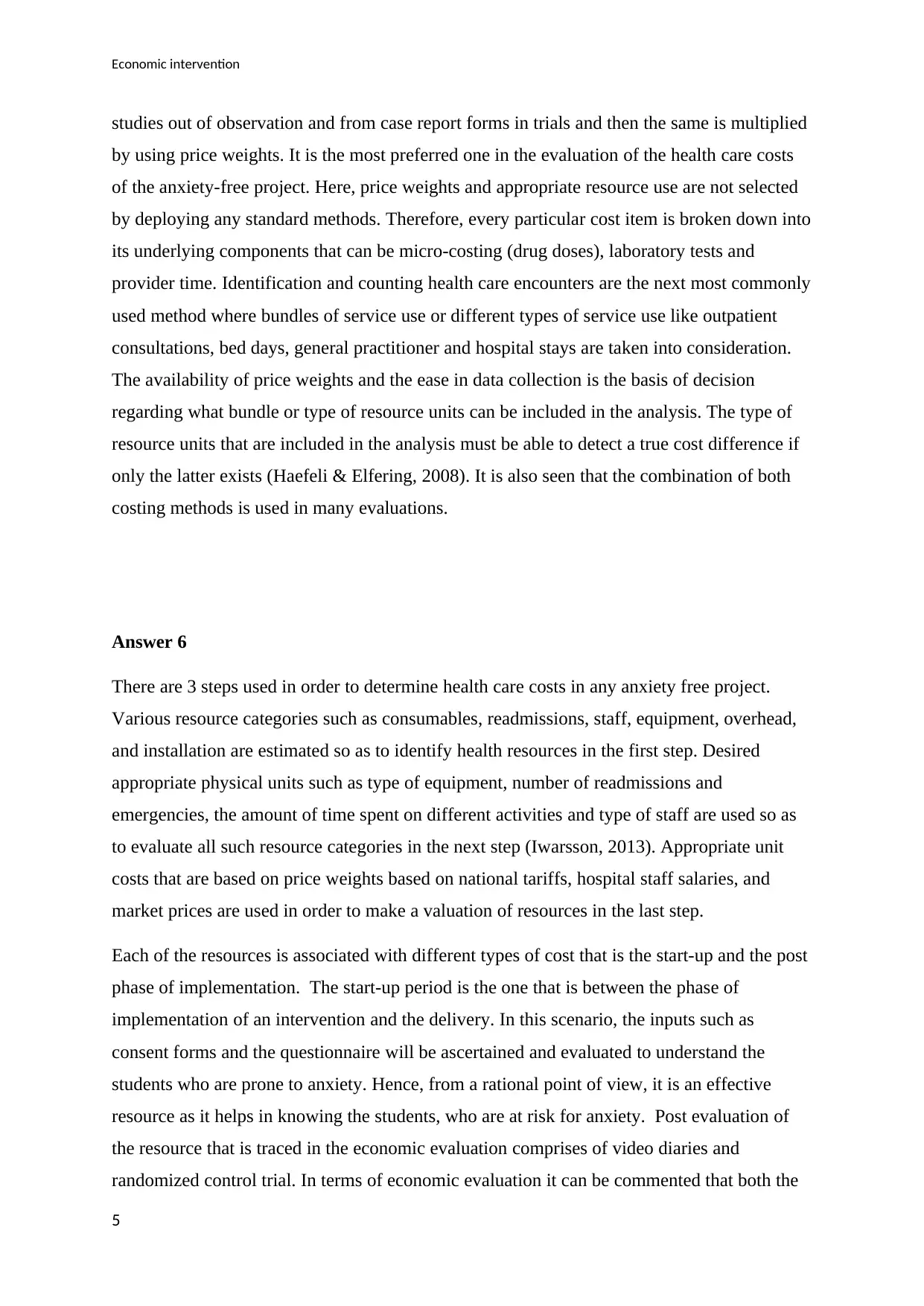
Economic intervention
studies out of observation and from case report forms in trials and then the same is multiplied
by using price weights. It is the most preferred one in the evaluation of the health care costs
of the anxiety-free project. Here, price weights and appropriate resource use are not selected
by deploying any standard methods. Therefore, every particular cost item is broken down into
its underlying components that can be micro-costing (drug doses), laboratory tests and
provider time. Identification and counting health care encounters are the next most commonly
used method where bundles of service use or different types of service use like outpatient
consultations, bed days, general practitioner and hospital stays are taken into consideration.
The availability of price weights and the ease in data collection is the basis of decision
regarding what bundle or type of resource units can be included in the analysis. The type of
resource units that are included in the analysis must be able to detect a true cost difference if
only the latter exists (Haefeli & Elfering, 2008). It is also seen that the combination of both
costing methods is used in many evaluations.
Answer 6
There are 3 steps used in order to determine health care costs in any anxiety free project.
Various resource categories such as consumables, readmissions, staff, equipment, overhead,
and installation are estimated so as to identify health resources in the first step. Desired
appropriate physical units such as type of equipment, number of readmissions and
emergencies, the amount of time spent on different activities and type of staff are used so as
to evaluate all such resource categories in the next step (Iwarsson, 2013). Appropriate unit
costs that are based on price weights based on national tariffs, hospital staff salaries, and
market prices are used in order to make a valuation of resources in the last step.
Each of the resources is associated with different types of cost that is the start-up and the post
phase of implementation. The start-up period is the one that is between the phase of
implementation of an intervention and the delivery. In this scenario, the inputs such as
consent forms and the questionnaire will be ascertained and evaluated to understand the
students who are prone to anxiety. Hence, from a rational point of view, it is an effective
resource as it helps in knowing the students, who are at risk for anxiety. Post evaluation of
the resource that is traced in the economic evaluation comprises of video diaries and
randomized control trial. In terms of economic evaluation it can be commented that both the
5
studies out of observation and from case report forms in trials and then the same is multiplied
by using price weights. It is the most preferred one in the evaluation of the health care costs
of the anxiety-free project. Here, price weights and appropriate resource use are not selected
by deploying any standard methods. Therefore, every particular cost item is broken down into
its underlying components that can be micro-costing (drug doses), laboratory tests and
provider time. Identification and counting health care encounters are the next most commonly
used method where bundles of service use or different types of service use like outpatient
consultations, bed days, general practitioner and hospital stays are taken into consideration.
The availability of price weights and the ease in data collection is the basis of decision
regarding what bundle or type of resource units can be included in the analysis. The type of
resource units that are included in the analysis must be able to detect a true cost difference if
only the latter exists (Haefeli & Elfering, 2008). It is also seen that the combination of both
costing methods is used in many evaluations.
Answer 6
There are 3 steps used in order to determine health care costs in any anxiety free project.
Various resource categories such as consumables, readmissions, staff, equipment, overhead,
and installation are estimated so as to identify health resources in the first step. Desired
appropriate physical units such as type of equipment, number of readmissions and
emergencies, the amount of time spent on different activities and type of staff are used so as
to evaluate all such resource categories in the next step (Iwarsson, 2013). Appropriate unit
costs that are based on price weights based on national tariffs, hospital staff salaries, and
market prices are used in order to make a valuation of resources in the last step.
Each of the resources is associated with different types of cost that is the start-up and the post
phase of implementation. The start-up period is the one that is between the phase of
implementation of an intervention and the delivery. In this scenario, the inputs such as
consent forms and the questionnaire will be ascertained and evaluated to understand the
students who are prone to anxiety. Hence, from a rational point of view, it is an effective
resource as it helps in knowing the students, who are at risk for anxiety. Post evaluation of
the resource that is traced in the economic evaluation comprises of video diaries and
randomized control trial. In terms of economic evaluation it can be commented that both the
5
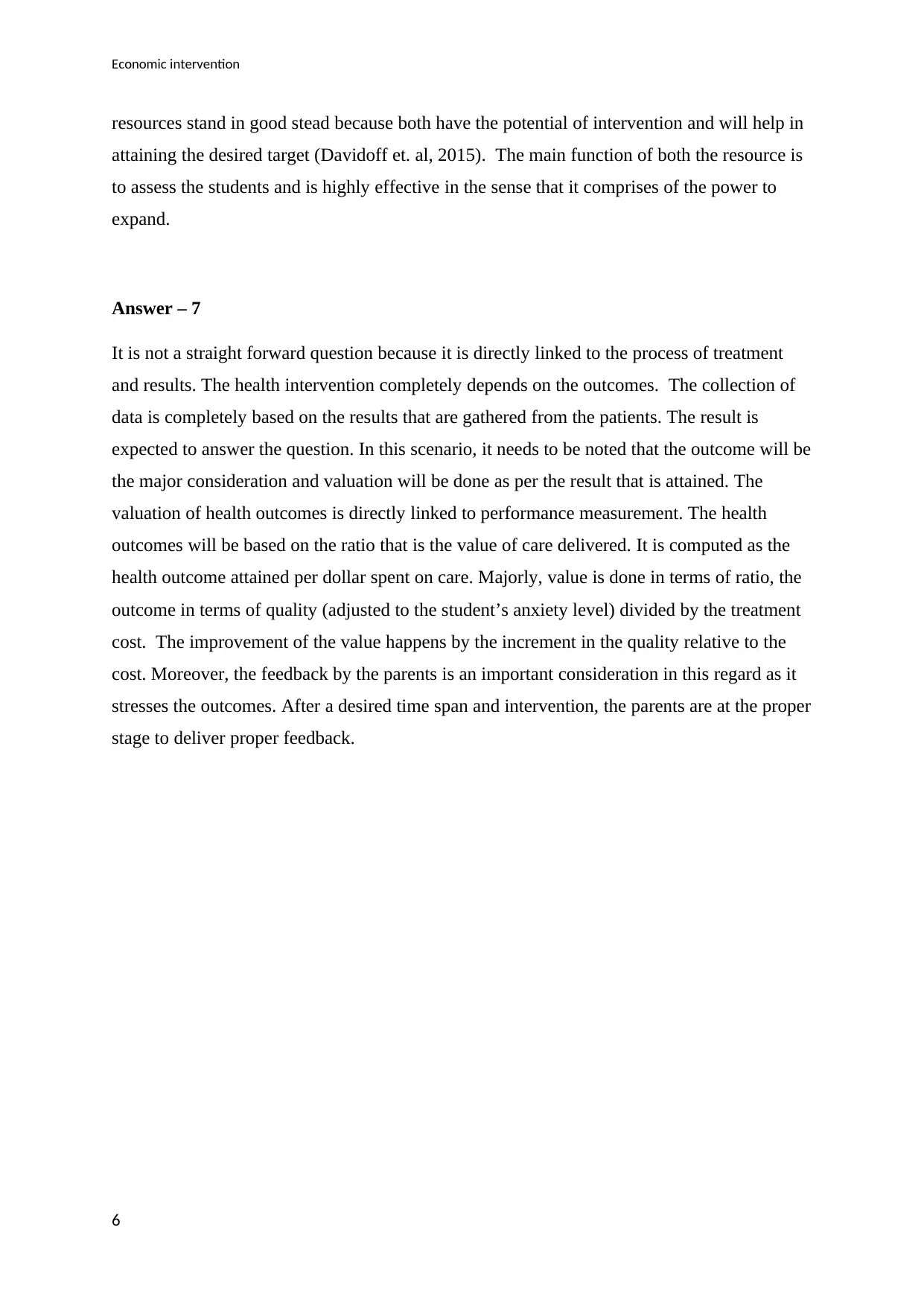
Economic intervention
resources stand in good stead because both have the potential of intervention and will help in
attaining the desired target (Davidoff et. al, 2015). The main function of both the resource is
to assess the students and is highly effective in the sense that it comprises of the power to
expand.
Answer – 7
It is not a straight forward question because it is directly linked to the process of treatment
and results. The health intervention completely depends on the outcomes. The collection of
data is completely based on the results that are gathered from the patients. The result is
expected to answer the question. In this scenario, it needs to be noted that the outcome will be
the major consideration and valuation will be done as per the result that is attained. The
valuation of health outcomes is directly linked to performance measurement. The health
outcomes will be based on the ratio that is the value of care delivered. It is computed as the
health outcome attained per dollar spent on care. Majorly, value is done in terms of ratio, the
outcome in terms of quality (adjusted to the student’s anxiety level) divided by the treatment
cost. The improvement of the value happens by the increment in the quality relative to the
cost. Moreover, the feedback by the parents is an important consideration in this regard as it
stresses the outcomes. After a desired time span and intervention, the parents are at the proper
stage to deliver proper feedback.
6
resources stand in good stead because both have the potential of intervention and will help in
attaining the desired target (Davidoff et. al, 2015). The main function of both the resource is
to assess the students and is highly effective in the sense that it comprises of the power to
expand.
Answer – 7
It is not a straight forward question because it is directly linked to the process of treatment
and results. The health intervention completely depends on the outcomes. The collection of
data is completely based on the results that are gathered from the patients. The result is
expected to answer the question. In this scenario, it needs to be noted that the outcome will be
the major consideration and valuation will be done as per the result that is attained. The
valuation of health outcomes is directly linked to performance measurement. The health
outcomes will be based on the ratio that is the value of care delivered. It is computed as the
health outcome attained per dollar spent on care. Majorly, value is done in terms of ratio, the
outcome in terms of quality (adjusted to the student’s anxiety level) divided by the treatment
cost. The improvement of the value happens by the increment in the quality relative to the
cost. Moreover, the feedback by the parents is an important consideration in this regard as it
stresses the outcomes. After a desired time span and intervention, the parents are at the proper
stage to deliver proper feedback.
6
⊘ This is a preview!⊘
Do you want full access?
Subscribe today to unlock all pages.

Trusted by 1+ million students worldwide
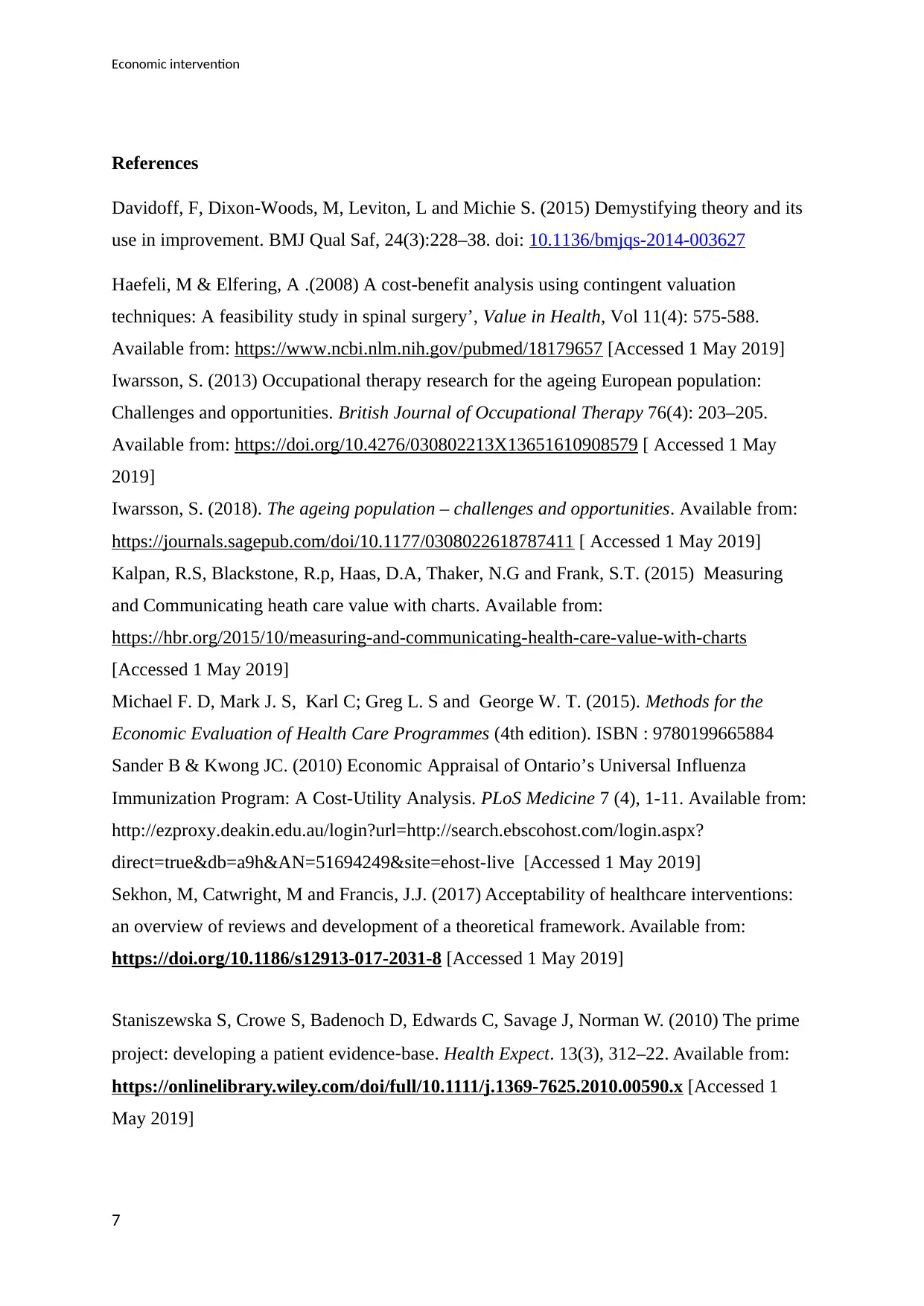
Economic intervention
References
Davidoff, F, Dixon-Woods, M, Leviton, L and Michie S. (2015) Demystifying theory and its
use in improvement. BMJ Qual Saf, 24(3):228–38. doi: 10.1136/bmjqs-2014-003627
Haefeli, M & Elfering, A .(2008) A cost-benefit analysis using contingent valuation
techniques: A feasibility study in spinal surgery’, Value in Health, Vol 11(4): 575-588.
Available from: https://www.ncbi.nlm.nih.gov/pubmed/18179657 [Accessed 1 May 2019]
Iwarsson, S. (2013) Occupational therapy research for the ageing European population:
Challenges and opportunities. British Journal of Occupational Therapy 76(4): 203–205.
Available from: https://doi.org/10.4276/030802213X13651610908579 [ Accessed 1 May
2019]
Iwarsson, S. (2018). The ageing population – challenges and opportunities. Available from:
https://journals.sagepub.com/doi/10.1177/0308022618787411 [ Accessed 1 May 2019]
Kalpan, R.S, Blackstone, R.p, Haas, D.A, Thaker, N.G and Frank, S.T. (2015) Measuring
and Communicating heath care value with charts. Available from:
https://hbr.org/2015/10/measuring-and-communicating-health-care-value-with-charts
[Accessed 1 May 2019]
Michael F. D, Mark J. S, Karl C; Greg L. S and George W. T. (2015). Methods for the
Economic Evaluation of Health Care Programmes (4th edition). ISBN : 9780199665884
Sander B & Kwong JC. (2010) Economic Appraisal of Ontario’s Universal Influenza
Immunization Program: A Cost-Utility Analysis. PLoS Medicine 7 (4), 1-11. Available from:
http://ezproxy.deakin.edu.au/login?url=http://search.ebscohost.com/login.aspx?
direct=true&db=a9h&AN=51694249&site=ehost-live [Accessed 1 May 2019]
Sekhon, M, Catwright, M and Francis, J.J. (2017) Acceptability of healthcare interventions:
an overview of reviews and development of a theoretical framework. Available from:
https://doi.org/10.1186/s12913-017-2031-8 [Accessed 1 May 2019]
Staniszewska S, Crowe S, Badenoch D, Edwards C, Savage J, Norman W. (2010) The prime
project: developing a patient evidence‐base. Health Expect. 13(3), 312–22. Available from:
https://onlinelibrary.wiley.com/doi/full/10.1111/j.1369-7625.2010.00590.x [Accessed 1
May 2019]
7
References
Davidoff, F, Dixon-Woods, M, Leviton, L and Michie S. (2015) Demystifying theory and its
use in improvement. BMJ Qual Saf, 24(3):228–38. doi: 10.1136/bmjqs-2014-003627
Haefeli, M & Elfering, A .(2008) A cost-benefit analysis using contingent valuation
techniques: A feasibility study in spinal surgery’, Value in Health, Vol 11(4): 575-588.
Available from: https://www.ncbi.nlm.nih.gov/pubmed/18179657 [Accessed 1 May 2019]
Iwarsson, S. (2013) Occupational therapy research for the ageing European population:
Challenges and opportunities. British Journal of Occupational Therapy 76(4): 203–205.
Available from: https://doi.org/10.4276/030802213X13651610908579 [ Accessed 1 May
2019]
Iwarsson, S. (2018). The ageing population – challenges and opportunities. Available from:
https://journals.sagepub.com/doi/10.1177/0308022618787411 [ Accessed 1 May 2019]
Kalpan, R.S, Blackstone, R.p, Haas, D.A, Thaker, N.G and Frank, S.T. (2015) Measuring
and Communicating heath care value with charts. Available from:
https://hbr.org/2015/10/measuring-and-communicating-health-care-value-with-charts
[Accessed 1 May 2019]
Michael F. D, Mark J. S, Karl C; Greg L. S and George W. T. (2015). Methods for the
Economic Evaluation of Health Care Programmes (4th edition). ISBN : 9780199665884
Sander B & Kwong JC. (2010) Economic Appraisal of Ontario’s Universal Influenza
Immunization Program: A Cost-Utility Analysis. PLoS Medicine 7 (4), 1-11. Available from:
http://ezproxy.deakin.edu.au/login?url=http://search.ebscohost.com/login.aspx?
direct=true&db=a9h&AN=51694249&site=ehost-live [Accessed 1 May 2019]
Sekhon, M, Catwright, M and Francis, J.J. (2017) Acceptability of healthcare interventions:
an overview of reviews and development of a theoretical framework. Available from:
https://doi.org/10.1186/s12913-017-2031-8 [Accessed 1 May 2019]
Staniszewska S, Crowe S, Badenoch D, Edwards C, Savage J, Norman W. (2010) The prime
project: developing a patient evidence‐base. Health Expect. 13(3), 312–22. Available from:
https://onlinelibrary.wiley.com/doi/full/10.1111/j.1369-7625.2010.00590.x [Accessed 1
May 2019]
7
Paraphrase This Document
Need a fresh take? Get an instant paraphrase of this document with our AI Paraphraser
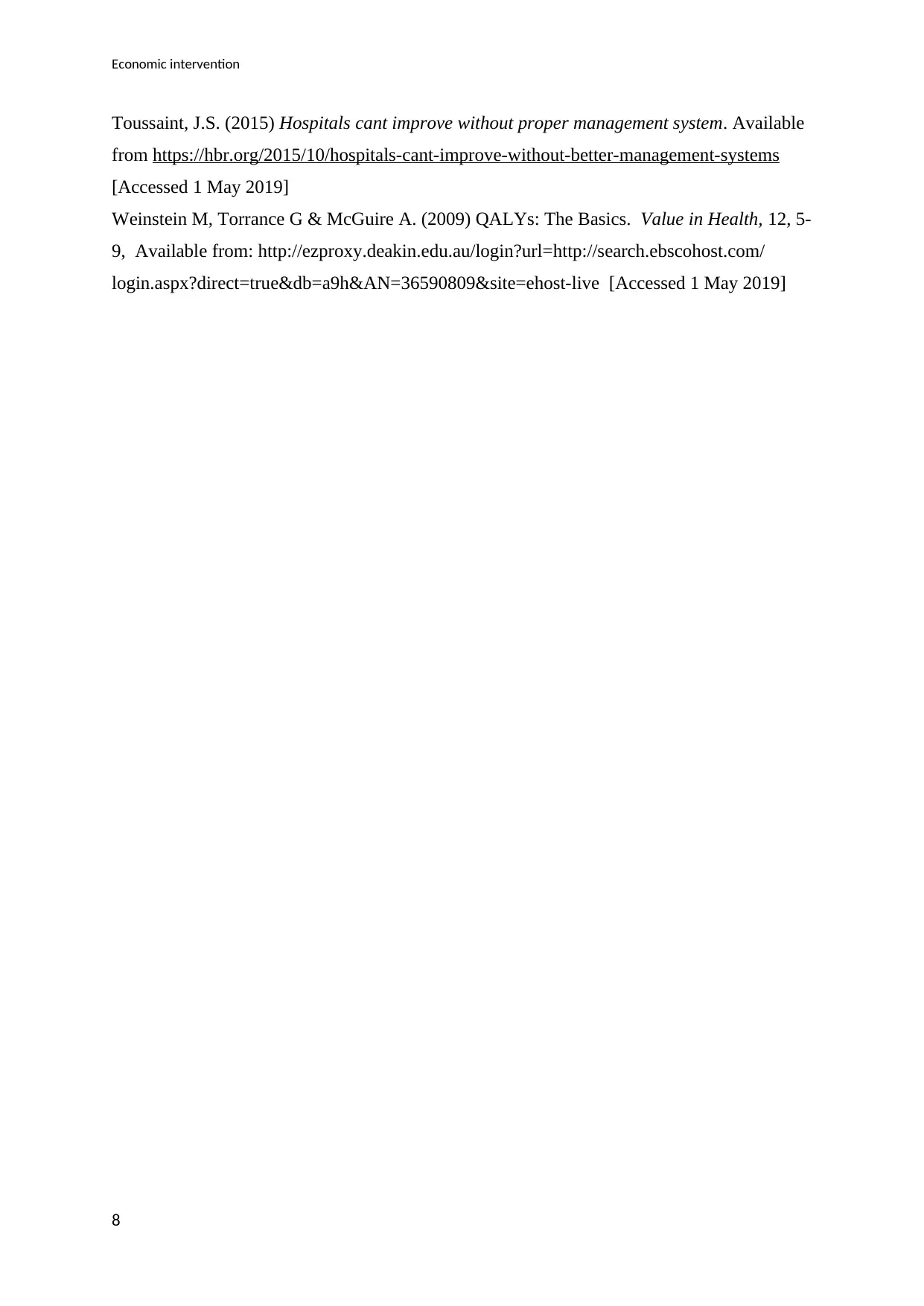
Economic intervention
Toussaint, J.S. (2015) Hospitals cant improve without proper management system. Available
from https://hbr.org/2015/10/hospitals-cant-improve-without-better-management-systems
[Accessed 1 May 2019]
Weinstein M, Torrance G & McGuire A. (2009) QALYs: The Basics. Value in Health, 12, 5-
9, Available from: http://ezproxy.deakin.edu.au/login?url=http://search.ebscohost.com/
login.aspx?direct=true&db=a9h&AN=36590809&site=ehost-live [Accessed 1 May 2019]
8
Toussaint, J.S. (2015) Hospitals cant improve without proper management system. Available
from https://hbr.org/2015/10/hospitals-cant-improve-without-better-management-systems
[Accessed 1 May 2019]
Weinstein M, Torrance G & McGuire A. (2009) QALYs: The Basics. Value in Health, 12, 5-
9, Available from: http://ezproxy.deakin.edu.au/login?url=http://search.ebscohost.com/
login.aspx?direct=true&db=a9h&AN=36590809&site=ehost-live [Accessed 1 May 2019]
8
1 out of 8
Related Documents
Your All-in-One AI-Powered Toolkit for Academic Success.
+13062052269
info@desklib.com
Available 24*7 on WhatsApp / Email
![[object Object]](/_next/static/media/star-bottom.7253800d.svg)
Unlock your academic potential
Copyright © 2020–2025 A2Z Services. All Rights Reserved. Developed and managed by ZUCOL.





